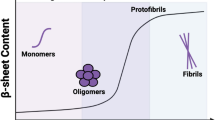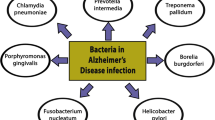Abstract
It is well established that infection has a significant detrimental effect on patients with Alzheimer’s disease (AD), accelerating cognitive decline and, even in healthy ageing individuals, increasing amyloid-β (Aβ) accumulation in the brain. In animal models of AD infection can also cause damage, with evidence of increased neuroinflammation, amyloid pathology and deterioration of cognitive function. These changes are against a backdrop of an age- and AD-related increase in susceptibility to infection. Here we set out to determine whether FTY720, a molecule that binds sphingosine-1-phosphate (S1P) receptors and with known immunosuppressant effects mediating its therapeutic action in multiple sclerosis (MS), might modulate the impact of infection in a mouse model of AD. Transgenic mice that overexpress amyloid precursor protein (APP) and presenilin 1 (PS1; APP/PS1 mice) and their littermates were/were not infected with Bordetella pertussis and were treated orally with FTY720 or vehicle beginning 3 days before infection. Infection increased astrocytic activation and enhanced blood brain barrier (BBB) permeability and these changes were attenuated in FTY720-treated B. pertussis-infected mice. Significantly, infection increased Aβ containing plaques and soluble Aβ and these infection-related changes were also attenuated in FTY720-treated B. pertussis-infected mice. The data suggest that this effect results from an FTY720-induced increase in Aβ phagocytosis by astrocytes. FTY720 did not impact on genotype-related changes in the absence of an infection indicating that its potential usefulness is restricted to reducing the impact of acute inflammatory stimuli in AD.







Similar content being viewed by others
References
Abbott NJ, Ronnback L, Hansson E (2006) Astrocyte-endothelial interactions at the blood-brain barrier. Nat Rev Neurosci 7:41–53
Adachi K, Kohara T, Nakao N, Chiba K, Mishina T, Sasaki S, Fujita T (1995) Design, synthesis, and structure-activity relationships of 2-substituted-2-amino-1,3-propanediols: Discovery of a novel immunosuppressant, FTY720, Bioorg Med Chem Lett 5:853–856
Alvarez JI, Cayrol R, Prat A (2011) Disruption of central nervous system barriers in multiple sclerosis. Biochim Biophys Acta 1812:252–264
Alvarez JI, Katayama T, Prat A (2013) Glial influence on the blood brain barrier. Glia 61:1939–1958
Brinkmann V, Davis MD, Heise CE, Albert R, Cottens S, Hof R, Bruns C, Prieschl E, Baumruker T, Hiestand P, Foster CA, Zollinger M, Lynch KR (2002) The immune modulator FTY720 targets sphingosine 1-phosphate receptors: J Biol Chem 277:21453–7
Brinkmann V, Billich A, Baumruker T, Heining P, Schmouder R, Francis G, Aradhye S, Burtin P (2010) Fingolimod (FTY720): discovery and development of an oral drug to treat multiple sclerosis: Nat Rev Drug Discov 9:883–97
Browne TC, McQuillan K, McManus RM, O'Reilly JA, Mills KH, Lynch MA (2013) IFN-gamma production by amyloid beta-specific Th1 cells promotes microglial activation and increases plaque burden in a mouse model of Alzheimer's disease. J Immunol 190:2241–2251
Bu XL et al (2015) A study on the association between infectious burden and Alzheimer's disease. European Journal of Neurology : the Official Journal of the European Federation of Neurological Societies 22:1519–1525
Choi JW, Gardell SE, Herr DR, Rivera R, Lee CW, Noguchi K, Teo ST, Yung YC, Lu M, Kennedy G, Chun J (2011) FTY720 (fingolimod) efficacy in an animal model of multiple sclerosis requires astrocyte sphingosine 1-phosphate receptor 1 (S1P1) modulation. Proc Natl Acad Sci U S A 108:751–756
Colombo E, Di Dario M, Capitolo E, Chaabane L, Newcombe J, Martino G, Farina C (2014) Fingolimod may support neuroprotection via blockade of astrocyte nitric oxide. Ann Neurol 76:325–337
Couturier J, Stancu IC, Schakman O, Pierrot N, Huaux F, Kienlen-Campard P, Dewachter I, Octave JN (2016) Activation of phagocytic activity in astrocytes by reduced expression of the inflammasome component ASC and its implication in a mouse model of Alzheimer disease. J Neuroinflammation 13:20
Dev KK, Mullershausen F, Mattes H, Kuhn RR, Bilbe G, Hoyer D, Mir A (2008) Brain sphingosine-1-phosphate receptors: implication for FTY720 in the treatment of multiple sclerosis. Pharmacol Ther 117:77–93
Foster CA, Howard LM, Schweitzer A, Persohn E, Hiestand PC, Balatoni B, Reuschel R, Beerli C, Schwartz M, Billich A (2007) Brain penetration of the oral immunomodulatory drug FTY720 and its phosphorylation in the central nervous system during experimental autoimmune encephalomyelitis: consequences for mode of action in multiple sclerosis. J Pharmacol Exp Ther 323:469–475
Hoffmann FS, Hofereiter J, Rubsamen H, Melms J, Schwarz S, Faber H, Weber P, Putz B, Loleit V, Weber F, Hohlfeld R, Meinl E, Krumbholz M (2015) Fingolimod induces neuroprotective factors in human astrocytes. J Neuroinflammation 12:184
Holmes C, El-Okl M, Williams AL, Cunningham C, Wilcockson D, Perry VH (2003) Systemic infection, interleukin 1beta, and cognitive decline in Alzheimer's disease. J Neurol Neurosurg Psychiatry 74:788–9
Holmes C, Cunningham C, Zotova E, Woolford J, Dean C, Kerr S, Culliford D, Perry VH (2009) Systemic inflammation and disease progression in Alzheimer disease: Neurology 73:768–74
Jones RS, Minogue AM, Connor TJ, Lynch MA (2013) Amyloid-beta-induced astrocytic phagocytosis is mediated by CD36, CD47 and RAGE. J NeuroImmune Pharmacol 8:301–311
Kahn MS, Kranjac D, Alonzo CA, Haase JH, Cedillos RO, McLinden KA, Boehm GW, Chumley MJ (2012) Prolonged elevation in hippocampal Abeta and cognitive deficits following repeated endotoxin exposure in the mouse. Behav Brain Res 229:176–184
Kamer AR, Pirraglia E, Tsui W, Rusinek H, Vallabhajosula S, Mosconi L, Yi L, McHugh P, Craig RG, Svetcov S, Linker R, Shi C, Glodzik L, Williams S, Corby P, Saxena D, de Leon MJ (2015) Periodontal disease associates with higher brain amyloid load in normal elderly. Neurobiol Aging 36:627–633
Kappos L, Antel J, Comi G, Montalban X, O'Connor P, Polman CH, Haas T, Korn AA, Karlsson G, Radue EW; FTY720 D2201 Study Group (2006) Oral fingolimod (FTY720) for relapsing multiple sclerosis: N Engl J Med 355:1124–40
Kappos L, Radue EW, O'Connor P, Polman C, Hohlfeld R, Calabresi P, Selmaj K, Agoropoulou C, Leyk M, Zhang-Auberson L, Burtin P; FREEDOMS Study Group (2010) A placebo-controlled trial of oral fingolimod in relapsing multiple sclerosis: N Engl J Med 362:387–401
Karch CM, Goate AM (2015) Alzheimer's disease risk genes and mechanisms of disease pathogenesis. Biol Psychiatry 77:43–51
Kelly RJ, Minogue AM, Lyons A, Jones RS, Browne TC, Costello DA, Denieffe S, O'Sullivan C, Connor TJ, Lynch MA (2013) Glial activation in a beta PP/PS1 mice is associated with infiltration of IFN gamma-producing cells. J Alzheimers Dis 37:63–75
Liao YF, Wang BJ, Cheng HT, Kuo LH, Wolfe MS (2004) Tumor necrosis factor-alpha, interleukin-1beta, and interferon-gamma stimulate gamma-secretase-mediated cleavage of amyloid precursor protein through a JNK-dependent MAPK pathway. J Biol Chem 279:49523–49532
Lyons A, Griffin RJ, Costelloe CE, Clarke RM, Lynch MA (2007) IL-4 attenuates the neuroinflammation induced by amyloid-beta in vivo and in vitro. J Neurochem 101:771–781
Mahmoudvand H, Sheibani V, Shojaee S, Mirbadie SR, Keshavarz H, Esmaeelpour K, Keyhani AR, Ziaali N (2016) Toxoplasma gondii infection potentiates cognitive impairments of Alzheimer's disease in the BALB/c mice. J Parasitol 102:629–635
McManus RM, Heneka MT (2017) Role of neuroinflammation in neurodegeneration: new insights. Alzheimers Res Ther 9:14
McManus RM, Higgins SC, Mills KH, Lynch MA (2014) Respiratory infection promotes T cell infiltration and amyloid-beta deposition in APP/PS1 mice. Neurobiol Aging 35:109–121
McQuiston T, Luberto C, Del Poeta M (2011) Role of sphingosine-1-phosphate (S1P) and S1P receptor 2 in the phagocytosis of Cryptococcus neoformans by alveolar macrophages. Microbiology 157:1416–1427
Minogue AM, Jones RS, Kelly RJ, McDonald CL, Connor TJ, Lynch MA (2014) Age-associated dysregulation of microglial activation is coupled with enhanced blood-brain barrier permeability and pathology in APP/PS1 mice. Neurobiol Aging 35:1442–1452
Montacute R, Foley K, Forman R, Else KJ, Cruickshank SM, Allan SM (2017) Enhanced susceptibility of triple transgenic Alzheimer's disease (3xTg-AD) mice to acute infection. J Neuroinflammation 14:50
Morris MA, Gibb DR, Picard F, Brinkmann V, Straume M, Ley K (2005) Transient T cell accumulation in lymph nodes and sustained lymphopenia in mice treated with FTY720: Eur J Immunol 35:3570–80
Natarajan V, Dudek SM, Jacobson JR, Moreno-Vinasco L, Huang LS, Abassi T, Mathew B, Zhao Y, Wang L, Bittman R, Weichselbaum R, Berdyshev E, Garcia JG (2013) Sphingosine-1-phosphate, FTY720, and sphingosine-1-phosphate receptors in the pathobiology of acute lung injury. Am J Respir Cell Mol Biol 49:6–17
Nishihara H, Shimizu F, Sano Y, Takeshita Y, Maeda T, Abe M, Koga M, Kanda T (2015) Fingolimod prevents blood-brain barrier disruption induced by the sera from patients with multiple sclerosis. PLoS One 10:e0121488
Osinde M, Mullershausen F, Dev KK (2007) Phosphorylated FTY720 stimulates ERK phosphorylation in astrocytes via S1P receptors. Neuropharmacology 52:1210–1218
Sastre M, Walter J, Gentleman SM (2008) Interactions between APP secretases and inflammatory mediators. J Neuroinflammation 5:25
Spampinato SF, Obermeier B, Cotleur A, Love A, Takeshita Y, Sano Y, Kanda T, Ransohoff RM (2015) Sphingosine 1 phosphate at the blood brain barrier: can the modulation of S1P receptor 1 influence the response of endothelial cells and astrocytes to inflammatory stimuli? PLoS One 10:e0133392
Suzuki S, Li XK, Enosawa S, Shinomiya T (1996) A new immunosuppressant, FTY720, induces bcl-2-associated apoptotic cell death in human lymphocytes: Immunology 89:518–23
Tuominen VJ, Ruotoistenmaki S, Viitanen A, Jumppanen M, Isola J (2010) ImmunoRatio: a publicly available web application for quantitative image analysis of estrogen receptor (ER), progesterone receptor (PR), and Ki-67. Breast Cancer Res 12:R56
Wang WY, Tan MS, Yu JT, Tan L (2015) Role of pro-inflammatory cytokines released from microglia in Alzheimer's disease. Ann Transl Med 3:136
Zeng X, Wang T, Zhu C, Xing X, Ye Y, Lai X, Song B, Zeng Y (2012) Topographical and biological evidence revealed FTY720-mediated anergy-polarization of mouse bone marrow-derived dendritic cells in vitro. PLoS One 7:e34830
Acknowledgments
This work was supported by grants from Science Foundation Ireland to KHGM (11/PI/1036) and MAL (11/PI/10154) and an Innovation Bursary (to KHGM and MAL from Trinity College Dublin).
Author information
Authors and Affiliations
Corresponding author
Ethics declarations
Conflict of Interest
Kingston Mills is a co-founder and shareholder in Opsona Therapeutics Ltd. and TriMod Therapeutics Ltd., university spin-out companies involved in the development of immunotherapeutics.
Rights and permissions
About this article
Cite this article
McManus, R.M., Finucane, O.M., Wilk, M.M. et al. FTY720 Attenuates Infection-Induced Enhancement of Aβ Accumulation in APP/PS1 Mice by Modulating Astrocytic Activation. J Neuroimmune Pharmacol 12, 670–681 (2017). https://doi.org/10.1007/s11481-017-9753-6
Received:
Accepted:
Published:
Issue Date:
DOI: https://doi.org/10.1007/s11481-017-9753-6




